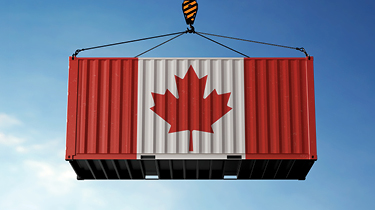How Canadian tariffs on U.S. goods may affect your business in 2025
Canadian companies that import goods from the United States (U.S.) will likely pay more for certain raw materials, foods and manufactured products as a result of new tariffs.
The Government of Canada has announced countermeasures to be implemented in two phases.
1. As of March 4, 25% tariffs on $30 billion worth of U.S. goods.
2. Tariffs will be applied to another $125 billion worth of American imports later this month following a consultation period.
Both will impact Canadian importers and exporters, particularly those with global supply chains.
This article covers which goods are affected, the potential impact on your supply chains and actionable strategies to help you mitigate the effects of these tariffs.
Canada’s tariffs are a direct response to U.S. tariffs imposed on Canadian goods. On March 4, 2025, after a 30-day pause, the U.S. implemented 25% tariffs on Canadian exports and 10% tariffs on Canadian energy. Additional 25% tariffs on foreign steel and aluminum are expected on March 12.
Canada and the U.S. share one of the world’s largest trading relationships, with billions of dollars’ worth of goods and services crossing the border daily. This trade partnership is important to both economies, supporting millions of jobs.
In a statement, Prime Minister Justin Trudeau said Canada’s tariffs would remain in effect until U.S. trade action is withdrawn.

The first phase of Canada’s response includes tariffs on $30 billion in goods imported from the U.S. The Government of Canada has issued a full list of products affected, including:
- orange juice
- peanut butter
- wine
- spirits
- beer
- coffee
- appliances
- apparel
- footwear
- motorcycles
- cosmetics
- pulp and paper
A second phase, which is set to start on March 25, 2025, could add $125 billion more in affected goods, including:
- electric vehicles (EVs)
- steel and aluminum products
- fruits and vegetables
- beef, pork and dairy
- electronics
- trucks and buses
To find out if your goods will be affected by tariffs, here’s a guide to help you:
1. Use the Canada Tariff Finder: The Canada Tariff Finder is a tool that provides information on products where Canada has a trade agreement. This is a good first step to check if your products may be affected by Canada’s new tariffs.
2. Understand rules of origin: Rules of origin identify the source country of a product and determine whether tariffs apply. This can be complex, as many products may originate from other countries, but are modified or repackaged in the U.S. For example, coffee beans grown in South America, but repackaged in the U.S., may be subject to Canada’s new tariffs.
The Government of Canada has information about CUSMA rules of origin for Canadian businesses importing goods from the U.S., as well as additional online tools to search for tariffs by product and country. You can also check out the rules of origin facilitator for additional information on tariffs and trade agreements.
3. Find your product’s Harmonized System (HS) classification: The HS classification system assigns a unique six-digit code to all products, making it easier to identify tariff obligations. You can find HS codes on documentation provided by your supplier, or through online HS tools. Once you have the HS code, you can use it alongside the Canada Tariff Finder to confirm whether tariffs apply to your products.
4. Consult a trade expert: The rules can be complicated. Working with a trade expert can save you time and reduce errors. You can reach out to a customs broker through the Canadian Society of Customs Brokers (CSCB) or freight forwarder for support. EDC’s Export Help Hub also provides answers to frequently asked trade questions.
If your company imports goods from the U.S., you’ll likely face higher prices for these items once the Canadian tariff is applied.
The tariffs are also expected to affect Canadian companies that sell internationally. Importing to export is a common practice. Many Canadian firms that sell abroad are tightly integrated into global and North American supply chains. This means components of products and partially completed goods criss-cross the Canada-U.S. border several times before reaching the final buyer.
In industries, like automotive manufacturing, these tariffs could increase costs significantly and cause shipment delays.

Business leaders have an opportunity to share their perspectives during the public comment period for the second phase of tariffs. The 21-day consultation allows you to provide feedback on the proposed measures and their potential economic impacts on your business.
What you can do:
- Take part in the public comment period to voice your concerns. If the product you’re importing is affected by the proposed tariffs, you have an opportunity to make a strong case to the Canadian government to have it removed.
- Find industry associations or trade organizations to amplify your concerns.
- Connect with your U.S. suppliers and ask them to lobby their representatives to remove tariffs on your products.
When the tariffs take effect, they’ll apply to all qualifying U.S. goods entering Canada, affecting pricing and supply chains. This doesn’t apply to goods already in transit.
The Canadian Department of Finance is implementing the surtax, which will be administered by the Canada Border Services Agency (CBSA). Importers are responsible for paying the tariffs, unless your contract stipulates otherwise. The importer will get a detailed adjustment certificate and have to pay 25% more for the goods.
Remission applications
The federal government has outlined a process and provided a template for Canadian businesses to request relief from the payment of tariffs, or a refund of tariffs already paid. If you intend to use the remission process, be ready to provide detailed information about your operations, how you’re affected by the tariffs and why your business requires assistance.
You should also check out
Expert guidance on how to manage trade regulations, customs requirements and international contracts.
Here are suggestions for weathering changes in U.S. trade policies:
Review and update contracts
- The importer of record is responsible for paying tariffs. Consider negotiating a contract with U.S. suppliers to act as the importer of record, which can mean less administrative hassles for you. While they may pass down the cost of the tax to you, the buyer (importer of record) will still cover the administrative costs.
- In new contracts, specify who the importer of record is. Consult with a legal team to ensure the contract language is clear.

Explore alternative suppliers
- A diverse supply chain reduces the risks of future tariff changes. This may not be a short-term possibility, but expanding into new markets should be part of your long-term plan. There are a number of emerging markets, like the Indo-Pacific, Latin America and Europe, that are interested in working with Canadian businesses.
Take advantage of Canada’s support programs
- The Trade Commissioner Service (TCS) helps companies find partners in new markets and provides information on trade agreements, tariffs and sanctions.
- Business Development Bank of Canada (BDC) provides financing, growth and transition capital and venture capital to small- and medium-sized businesses.
We’re here to empower Canadian businesses, especially during times of trade uncertainty. Whether you’re dealing with higher costs and disrupted U.S. supply chains, or planning for long-term market diversification, we have financial and knowledge solutions to support you.
Financial solutions
- Credit insurance: Protect yourself against the risk of non-payment and improve cash flow for international trade.
- Working capital support: Gain access to the funds you need to manage rising costs or invest in adapting your operations.
- Export Guarantee Program: Work with your financial institution to secure additional credit with support from EDC.
Knowledge products
EDC isn’t just about financing—we also provide insights on international markets to help you succeed. From market reports to personalized advice, our experts can help you make informed decisions.
- U.S. market intelligence: Find additional resources and support about Canada’s largest export market.
- Market entry support: We can connect you with global buyers and provide market intelligence to help you find suppliers in regions, like the Indo-Pacific, Latin America and Europe.
- Webinars and insights: Stay updated with actionable insights to help you adapt to a shifting global trade environment.
Whether you need financial stability to overcome today’s challenges or guidance to seize future opportunities, we can help you stay resilient. Reach out to us to learn how.
You should also check out
Ensure your products meet CUSMA standards to avoid penalties and reduce trade risks.







